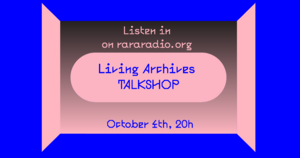The Living Archives Talkshop: Difference between revisions
No edit summary |
(Marked this version for translation) |
||
| (One intermediate revision by the same user not shown) | |||
| Line 1: | Line 1: | ||
<languages /> | |||
<translate> | |||
<!--T:1--> | |||
{{Event | {{Event | ||
|Name=The Living Archives Talkshop | |Name=The Living Archives Talkshop | ||
| Line 11: | Line 15: | ||
What is a living archive? What strategies for collective remembering can be fostered for communities, in and outside of institutions? | What is a living archive? What strategies for collective remembering can be fostered for communities, in and outside of institutions? | ||
<!--T:2--> | |||
[[File:00000020.livingarchivesimage.png|thumb]] | [[File:00000020.livingarchivesimage.png|thumb]] | ||
<!--T:3--> | |||
These are some of the questions we will be talkshopping (talking through) on the 4th of October, at 20h, at rararadio.org. | These are some of the questions we will be talkshopping (talking through) on the 4th of October, at 20h, at rararadio.org. | ||
The Living Archives Group has gathered a growing collection of MUMORIES from MU Hybrid Art House in Eindhoven, that literally gives voice to the immaterial impact cultural practice have on visitors. We are zooming in on the question of how to make archives a living, breathing entity rather than a silent material collection of the past. We understand a living archive as an interactive archive, where relationships and collaboration come from outside the walls of an institution. A living archive challenges normative and dominating classification systems, relating its parts with each other and forming stories around them. A living archive is generative, organic, ever-growing, shapeshifting, and subsequently slowly decaying. | The Living Archives Group has gathered a growing collection of MUMORIES from MU Hybrid Art House in Eindhoven, that literally gives voice to the immaterial impact cultural practice have on visitors. We are zooming in on the question of how to make archives a living, breathing entity rather than a silent material collection of the past. We understand a living archive as an interactive archive, where relationships and collaboration come from outside the walls of an institution. A living archive challenges normative and dominating classification systems, relating its parts with each other and forming stories around them. A living archive is generative, organic, ever-growing, shapeshifting, and subsequently slowly decaying. | ||
<!--T:4--> | |||
On the 4th of October, we intend to activate this living archive even more, as well as contextualising the project through dialogues and conversations both around notions of archiving and memory, and the 25 years of programming in MU. Together with participants Nadia Piet, Annet Dekker, Tabea Nixdorff, Remco van Bladel and Mariana Linari, Michael Murtaugh and Gaby Wijers, this Talkshop reflects on a range of archival experiments and how can living archives contribute to critical institutional memory-making. | On the 4th of October, we intend to activate this living archive even more, as well as contextualising the project through dialogues and conversations both around notions of archiving and memory, and the 25 years of programming in MU. Together with participants Nadia Piet, Annet Dekker, Tabea Nixdorff, Remco van Bladel and Mariana Linari, Michael Murtaugh and Gaby Wijers, this Talkshop reflects on a range of archival experiments and how can living archives contribute to critical institutional memory-making. | ||
</translate> | |||
Latest revision as of 14:00, 22 December 2023
| The Living Archives Talkshop | |
|---|---|
| Name | The Living Archives Talkshop |
| Location | rararadio.org |
| Date | 2023/10/04 |
| Time | 20:00-22:00 |
| PeopleOrganisations | Hackers & Designers, Varia, MU, Institute of Network Cultures, Nadia Piet, Annet Dekker, Remco van Bladel, Mariana Lanari, Michael Murtaugh, Gaby Wijers, Vivian van Gaal, Jasper van Es |
| Type | Meetup |
| Web | No |
| No | |
What is a living archive? What strategies for collective remembering can be fostered for communities, in and outside of institutions?
These are some of the questions we will be talkshopping (talking through) on the 4th of October, at 20h, at rararadio.org. The Living Archives Group has gathered a growing collection of MUMORIES from MU Hybrid Art House in Eindhoven, that literally gives voice to the immaterial impact cultural practice have on visitors. We are zooming in on the question of how to make archives a living, breathing entity rather than a silent material collection of the past. We understand a living archive as an interactive archive, where relationships and collaboration come from outside the walls of an institution. A living archive challenges normative and dominating classification systems, relating its parts with each other and forming stories around them. A living archive is generative, organic, ever-growing, shapeshifting, and subsequently slowly decaying.
On the 4th of October, we intend to activate this living archive even more, as well as contextualising the project through dialogues and conversations both around notions of archiving and memory, and the 25 years of programming in MU. Together with participants Nadia Piet, Annet Dekker, Tabea Nixdorff, Remco van Bladel and Mariana Linari, Michael Murtaugh and Gaby Wijers, this Talkshop reflects on a range of archival experiments and how can living archives contribute to critical institutional memory-making.
